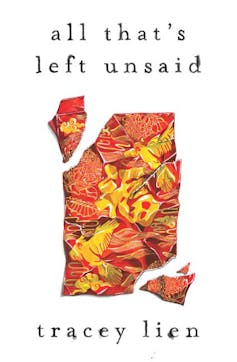
Bruce Lee famously gave the advice, “research your own experience”. In her debut novel, All That’s Left Unsaid, Tracey Lien researches her experience to convey the emotional complexity of Vietnamese refugee and immigrant experiences in Australia.
Lien was born and raised in South Western Sydney, and grew up in 1990s Cabramatta, where her enthralling murder mystery is set. She earned her Masters of Fine Arts at the University of Kansas and worked as a reporter for the Los Angeles Times.
Review: All That’s Left Unsaid – Tracey Lien (HQ Fiction)
A ‘model minority’ and drug crimes
In the opening pages of the novel, narrator Ky Tran returns from Melbourne (where she’s a cadet journalist) to Cabramatta for the funeral of her beloved brother, Denny Tran. Wearing his “Most Likely to Succeed” sash, Denny is stomped to death in a restaurant, Lucky 8, while celebrating his high school graduation. Everyone in the restaurant that night surely must have witnessed the murder in some way. But they all tell the police they were in the kitchen or bathroom at the time – and saw nothing.

Denny’s parents decide not to request an autopsy report: it won’t bring their son back to life. But Ky insists on investigating. She convinces the constable to give her the list of Vietnamese witnesses and uses her insider Vietnamese cultural knowledge and language – combined with her fledgling journalism skills – to personally interview the witnesses.
Fictionalising journalism is a tried-and-true sport, and Lien plays it well. Cabramatta is personified as “a paradox” that could be “gorgeous and sick, comforting and dangerous, imperfect but home [to the] best pho”.
Historically, Cabramatta has been equated with drug-related crimes, and subject to politicised media rhetoric about the resettlement of Vietnamese refugees. Their arrival coincided with Australia’s late-1970s transition from the White Australia Policy to multiculturalism.
So-called perfect people and nationalities are often paradoxical, embodying inherent contradictions. In this crime novel, Denny Tran represents the complex guilt and shame of a refugee community trying to fit the vision of a “model minority” within Australian multiculturalism – studious, hardworking, compliant.
But after his death, it’s presumed Denny was crushed by school pressure and caught up in the flipside of Vietnamese Cabramatta: the heroin use pandemic of the 1990s. At least – that is what the police, who don’t bother to question the witnesses’ silence, want to believe.
In fact, the witnesses have their own stories to tell and withhold. Most of the book is inhabited by deeply complex characterisations of Vietnamese people, exploring their lucky and unlucky outcomes in Australia. My favourite character is Flora, the restaurant’s wedding singer:
Onstage, dressed in a glittery green áo dài, hair in a beehive, face painted with rosy blush and a wing cat eye, a Valium dissolved in her stomach, Flora Huynh crooned for a bride and groom – the first wedding held at Lucky 8 since the incident nearly two weeks ago.
Flora’s character and her story are developed with the help of flashbacks, spanning ages ten to 34. Several complex storylines unfold, detailing her life and relationships in Vietnam and then Cabramatta.
Read more: War's physical toll can last for generations, as it has for the children of the Vietnam War
The luckiest country
There is never one story to any culture or place. This crime story set in 1990s Cabramatta is in part about Australian nationalism, and how it produces fraught paradigms of belonging and not belonging – since we are all immigrants on stolen Indigenous land.
Lien does not hold back in her critical characterisation of the racial conflicts that underlie this predicament in Australia. Another central thread of the novel is Ky’s recurring memories of her childhood best friend, Minnie, through different ages and stages of their lives in Cabramatta: Minnie’s mostly absent voice is present throughout the novel. At one point, Ky describes “white rage” that morphs into “disappointment”, in response to Minnie’s acerbic take on the “lucky country”:
They’re all fair dinkum this and everyone gets a fair go that. This is the luckiest country in the world, right? […] But they don’t tell us that the luck doesn’t extend to us. That’s the big lie. They’ve been shoving it down our throats since we were kids.
Perhaps Lien’s journalistic training in a highly racialised America coloured this confronting portrait of Vietnamese Australian migrant tragedy. How can you can do everything right, try something new – and still end up … here? The mystery of Denny Tran’s death is only resolved by confronting this very question.
Code-switching and cultural complexities
Various chapters are carefully crafted from the perspectives of different publicly silent witnesses to the crime: a teacher, the wedding singer, a child who was at the restaurant with her parents. The reader becomes detective and prosecutor of the characters’ human failures – and cannot help but feel compassion and understanding for their silence. These characters reflect our own failed state as human beings, disempowered as witnesses to violence, racism, and cultural and social misconduct.
As an oral historian who has listened to many life stories of Vietnamese refugees’ childhoods and worked with unaccompanied minors who became criminals in the US immigration and prison system, I am so impressed with how Lien built these characters and this story.
When Lien throws Vietnamese words into the mix, I recognise my own “insider” view – and the outside code-switching that goes with it. English-language readers, usually the implicit insiders in novels published in this country, will inhabit and learn the Vietnamese Australian perspective through reading this book.
For instance, the suspect gang for the murder is known as 5T. 5T stands for five words in Vietnamese, rumoured to mean “love, money, prison, punishment, suicide”. But when we learn the five words in Vietnamese, it instead translates to “childhood without love”.
Cultural historical studies strive to convey the complexities of the Vietnamese refugee experience, mostly using the English language. They unpack the meaning of concepts such as model minorities, immigrant expectations, colonialism, racism, violence and intergenerational trauma.
But in Lien’s novel, the language of the Vietnamese community itself is integral to understanding its characters, community and culture – and to solving the case of Denny’s murder.
The concepts investigated in cultural historical studies are integrated – and animated – in this novel. Cabramatta and the refugee children who grew up there in the 1990s are, in Lien’s pages, recognised as part of Australia’s complex cultural history. The result is more powerful – and conveys more – than most studies can.
Anh Nguyen Austen does not work for, consult, own shares in or receive funding from any company or organisation that would benefit from this article, and has disclosed no relevant affiliations beyond their academic appointment.
This article was originally published on The Conversation. Read the original article.







